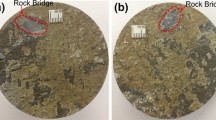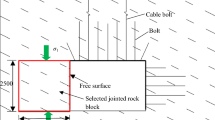Abstract
Particle flow code in two dimensions (PFC2D) was used to investigate the dynamic processes and hypermobility mechanisms of the loose deposit slope on the Ya’an-Kangding Expressway. The structure of the loose deposit slope is simulated by numerous balls that have different bonding strengths. A trial-and-error calibration and biaxial models were applied to determine micro-level parameters in PFC2D. The parallel bonds between particles, the velocity vector diagram, the displacement vector diagram, the porosity and the stress were analyzed in the numerical models. It was concluded that deep sedimentary basins can have large effects on the slope surface. Three different slip patterns were identified: sliding along the slope, collision of rocks in the down-slope, and breakthrough sandstone. The velocity vector diagram indicates that at the start, particles may move by falling, toppling, and sliding, but over time they begin to spread or flow. Particle location is a critical factor in the stability of loose deposit slope. Particle displacement is smaller at the top and center than at the bottom of the slope because the collision between the rock blocks involves momentum transfer, which causes the front of the mass to continue for a greater distance. The porosity of the surface slope generally increases with increasing seismic-wave loading time, while the porosity of the inner slope remains constant. The stress on the slope surface is much larger than that on the inner layer of the slope, indicating that seismic waves travel faster through hard rocks than through softer rocks and sediments.












Similar content being viewed by others
References
Campbell, C.S.: Self-lubrication for long runout landslides. J. Geol. 98(5), 794–796 (1989). https://doi.org/10.1086/629445
Cleary, P.W., Campbell, C.S.: Self-lubrication for long runout landslides: examination by computer simulation. J. Geophys. Res. [Solid Earth] 98(B12), 21911–21924 (1993). https://doi.org/10.1029/93JB02380
Cundall, P.A., Strack, O.D.L.: A discrete numerical model for granular assemblies. Geotechnique 29(1), 47–65 (1979)
Dai, F.C., Xu, C., Yao, X., Xu, L., Tu, X.B., Gong, Q.M.: Spatial distribution of landslides triggered by the 2008 Ms 8.0 Wenchuan earthquake, China. J. Asian Earth Sci. 40(3), 883–895 (2010). https://doi.org/10.1016/j.jseaes.2010.04.010
Deng, H.F., Zhou, M.L., Li, J.L., Sun, X.S., Huang, Y.L.: Creep degradation mechanism by water-rock interaction in the red-layer soft rock. Arab. J. Geosci. 9(12), 601–615 (2016). https://doi.org/10.1007/s12517-016-2604-6
He, J.M., Li, X., Li, S.D., Yin, Y.P., Qian, H.T.: Study of seismic response of colluvium accumulation slope by particle flow code. Granul. Matter 12(5), 483–490 (2010). https://doi.org/10.1007/s10035-010-0213-8
Huang, R.Q.: Mechanism and geomechanical modes of landslide hazards triggered by Wenchuan 8.0 earthquake. Chin. J. Rock Mech. Eng. 28(6), 1239–1249 (2009). https://doi.org/10.3321/j.issn:1000-6915.2009.06.021. in Chinese
Itasca Consulting Group Inc: PFC2D-particle flow code in 2 dimensions, user’s manual. Itasca, Minneapolis (2008)
Kang, C., Chan, D.: Numerical simulation of 2D granular flow entrainment using DEM. Granul. Matter 20(13), 1–17 (2018). https://doi.org/10.1007/s10035-017-0782-x
Lee, G.: The 512 Wenchuan earthquake of China: a preliminary report (2008). http://mceer.buffalo.edu/research/reconnaissance/china5-12-08/chinaeq6-15-08.pdf
Lim, W.L., McDowell, G.R.: Discrete element modelling of railway ballast. Granul. Matter 7(1), 19–29 (2005). https://doi.org/10.1007/s10035-004-0189-3
Lin, Y.L., Zhang, M.X., Javadi, A.A., Lu, Y., Zhang, S.L.: Experimental and DEM simulation of sandy soil reinforced with H-V inclusions in plane strain tests. Geosynth. Int. 20(3), 162–173 (2013). https://doi.org/10.1680/gein.13.00009
Meng, Y.W.: PFC2D simulation on stability of loose deposits slope in highway cutting excavation. Geotech. Geol. Eng. 35(2), 897–902 (2017). https://doi.org/10.1007/s10706-016-0143-2
Michael, D., Li, L.: Earthquake reconstruction in Wenchuan: assessing the state overall plan and addressing the forgotten phase. Appl. Geogr. 31(3), 998–1009 (2011). https://doi.org/10.1016/j.apgeog.2011.01.001
Mohamed, A., Gutierrez, M.: Comprehensive study of the effects of rolling resistance on the stress-strain and strain localization behavior of granular materials. Granul. Matter 12(5), 527–541 (2010). https://doi.org/10.1007/s10035-010-0211-x
Masson, S., Martinez, J.: Effect of particle mechanical properties on silo flow and stresses from distinct element simulations. Powder Technol. 109(1), 164–178 (2000). https://doi.org/10.1016/S0032-5910(99)00234-X
Okura, Y., Kitahara, H., Sammori, T., Kawanami, A.: The effects of rock fall volume on run out distance. Eng. Geol. 58(2), 109–124 (2000). https://doi.org/10.1016/S0013-7952(00)00049-1
Potyondy, D.O., Cundall, P.A.: A bonded-particle model for rock. Int. J. Rock Mech. Min. Sci. 41(8), 1329–1364 (2004). https://doi.org/10.1016/j.ijrmms.2004.09.011
Schöpfer, M.P.J., Childs, C., Walsh, J.J.: Two-dimensional distinct element modeling of the structure and growth of normal faults in multilayer sequences: 1. Model calibration, boundary conditions, and selected results. J. Geophys. Res. 112(B10), 1–15 (2007). https://doi.org/10.1029/2006JB004902
Sun, Z.L., Kong, L.W., Guo, A.G., Tian, H.: Surface deformations and failure mechanisms of deposit slope under seismic excitation. Rock Soil Mech. 32(12), 3465–3472 (2015). https://doi.org/10.16285/j.rsm.2015.12.017. in Chinese
Shi, C., Wang, S.N., Liu, L.: Research of avalanche disaster numerical simulation based on granular discrete element method of high-steep slope under seismic loads. Chin. J. Rock Mech. Eng. 32(S1), 2798–2805 (2013). https://doi.org/10.3969/j.issn.1000-6915.2013.z1.029. (in Chinese)
Tang, C.L., Hu, J.C., Lin, M.L., Angelier, J., Lu, C.Y., Chan, Y.C., Chu, H.T.: The Tsaoling landslide triggered by the Chi-Chi earthquake, Taiwan: insights from a discrete element simulation. Eng. Geol. 106(1–2), 1–19 (2009). https://doi.org/10.1016/j.enggeo.2009.02.011
Tuitz, C., Exner, U., Preh, A., Grasemann, B.: The influence of particle orientation on the loading condition of pebbles in fluvial gravel. Granul. Matter 14(5), 639–649 (2012). https://doi.org/10.1007/s10035-012-0365-9
Wang, C., Tannant, D.D., Lilly, P.A.: Numerical analysis of the stability of heavily jointed rock slopes using PFC2D. Int. J. Rock Mech. Min. Sci. 40(3), 415–424 (2003). https://doi.org/10.1016/S1365-1609(03)00004-2
Yang, Q.H., Yao, L.K., Ren, Z.M., Gao, Z.N.: Centrifugal model test of centrifuge dynamic characteristics landslide of loose slope under earthquake load. Chin. J. Rock Mech. Eng. 27(2), 368–374 (2008). https://doi.org/10.3321/j.issn:1000-6915.2008.02.020. (in Chinese)
Yang, Q.H., Yao, L.K., Yang, M.: Particle flow numerical simulation of landslip of loose slope under seismic loading. J. Southwest Jiaotong Univ. 44(4), 580–584 (2009). https://doi.org/10.3969/j.issn.0258-2724.2009.04.019. (in Chinese)
Zhang, L., Thornton, C.: A numerical examination of the direct shear test. Geotechnique 57(4), 343–354 (2007). https://doi.org/10.1680/geot.2007.57.4.343
Zhang, M.X., Qiu, C.C., Javadi, A.A., Lu, Y., Zhang, S.L.: Discrete-element method simulation of a model test of an embankment reinforced with horizontal-vertical inclusions. Geosynth. Int. 20(4), 238–251 (2013). https://doi.org/10.1680/gein.13.00014
Zhou, W., Yang, L.F., Ma, G., Chang, X.L., Cheng, Yg, Li, D.Q.: Macro-micro responses of crushable granular materials in simulated true triaxial tests. Granul. Matter 17(4), 497–509 (2015). https://doi.org/10.1007/s10035-015-0571-3
Zhou, W., Yang, L.F., Ma, G., Chang, X.L., Lai, Z.Q., Xu, K.: DEM analysis of the size effects on the behavior of crushable granular materials. Granul. Matter 18(3), 1–11 (2016). https://doi.org/10.1007/s10035-016-0656-7
Zhou, J., Chi, Y.W., Chi, Y., Xu, J.P.: Simulation of biaxial test on sand by particle flow code. Chin. J. Geotech. Eng. 22(6), 701–704 (2000). https://doi.org/10.3321/j.issn:1000-4548.2000.06.014. in Chinese
Zhou, J., Shi, D.D., Jia, M.C., Yan, D.X.: Numerical simulation of mechanical response on sand under monotonic loading by particle flow code. Chin. J. Geotech. Eng. 35(10), 1299–1304 (2007). https://doi.org/10.3321/j.issn:0253-374X.2007.10.002. in Chinese
Zhou, J., Liao, X.H., Chi, Y., Xu, J.P.: Simulating plane strain test of soils by particle flow code. J. Tongji Univ. 30(9), 1044–1050 (2002). https://doi.org/10.3321/j.issn:0253-374X.2002.09.003. in Chinese
Acknowledgements
The study was partly supported by the National Natural Science Foundation of China (Grant Nos. 41372280, 51778353, 41202215), which is gratefully acknowledged.
Author information
Authors and Affiliations
Corresponding author
Ethics declarations
Conflict of interest
The authors declare that they have no conflict of interest.
Rights and permissions
About this article
Cite this article
Hou, J., Zhang, M., Chen, Q. et al. Failure-mode analysis of loose deposit slope in Ya’an-Kangding Expressway under seismic loading using particle flow code. Granular Matter 21, 8 (2019). https://doi.org/10.1007/s10035-018-0859-1
Received:
Published:
DOI: https://doi.org/10.1007/s10035-018-0859-1




